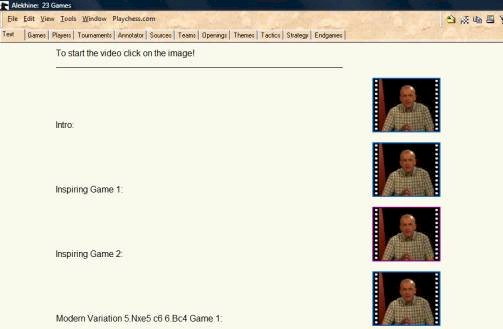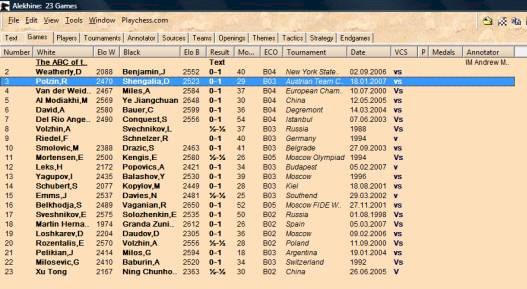Welcome to Easychess
![]()
Welcome to Easychess
|
 ABC of Alekhine by Andrew Martin (Fritztrainer Opening – by
Chessbase)
ABC of Alekhine by Andrew Martin (Fritztrainer Opening – by
Chessbase)Chess Reviews -
The Fritztrainer Opening (also known as the Fritz Media System)
series seeks to combine the benefits of a live lecture by a chess master and a database
which may be used with a chess engine.

In the diagram above we can see the various elements of the Fritz Media System in action. The bottom left window has Andrew Martin lecturing on and analysing the game displayed in the top windows. At the bottom right, we are running Fritz 11 which is analysing the position on the board. The value of chess video/DVD material when compared with books is clear: expert lectures by masters provide average players with a quick and easy route to learning new openings. Many people may also find this method to be a more relaxed way studying the game. Rather than having to tiptoe through the footnotes of intricate variations in books, the listener is immediately told what is and what is not important.
The sections or chapters of the DVD are accessed by using the mouse to click on the different photographic images of Andrew Martin.

Thus, in the diagram above, if you were to click on the image of Martin which is fourth down, you will get the lecture on the line 1 e4 Nf6 2 e5 Nd5 3 d4 d6 4 Nf3 de 5 Nxe5 c6 6 Bc4. In all, there are 25 chapters on this DVD which runs for over five hours.
Finally, the Fritz Media format gives you access to the games which have been commented on by Martin. All you have to do is switch from the Text to Games tab as shown in the diagram below.

Above you see the 23 games which form the chess content of this DVD. In order to get the games with Martin’s analysis, you select and double-click on the game you want – in our case this is Polzin v Shengalia. Play through this game with Martin’s notes to get an impression of the depth of his analysis.
|
(1) Polzin,R (2470) - Shengalia,D (2523) [B03]
|
I find the layout of this DVD clear enough for the non-computer
expert (the majority of us) to follow.
OK, enough about the format of the DVD. What about the ABC of Alekhine looked at
from the point of view of chess content?
In the introduction, Andrew Martin tells us that the repertoire he is about to suggest will be applicable for players all the way up to grandmaster level. As Magnus Carlsen has been playing 1 e4 Nf6 2 e5 Nd5 3 d4 d6 4 Nf3 de 5 Nxe5 c6 as an antidote to the 4 Nf3 main line, this may not be mere bravado from our sage. In addition to the main lines, Martin has several good ideas in side lines that are sound enough and don’t carry an enormous load of theory.
The material is divided as followings:
In my view, this is a pretty thorough coverage of this opening. The main points of note are:
a) 1.e4 Nf6 2.e5 Nd5 3.d4 d6 4.Nf3 dxe5 5.Nxe5 c6. Martin calls this the Miles Variation in the introductory section, but in the overview it is referred to as the Modern Variation. This has become a popular choice for black players who are not keen on playing 4...Bg4 or the Alburt line, 4...g6. 5...c6, intending eventually...Nd7 (the immediate 5 …Nd7 allows 6 Nxf7!?) makes perfect sense and the theory isn’t as well-developed as in the other lines after 4.Nf3. It is also quite solid and therefore less likely that Black will stumble into some razzle-dazzle preparation. Carlsen used this line to beat Topalov recently.
b) 1.e4 Nf6 2.e5 Nd5 3.d4 d6 4.c4 Nb6 5.f4 dxe5 6.fxe5 c5 7.d5 g6!?. This is a rather rare way of meeting the four pawns attack. It seems worth a try and may well catch your opponent out.
c) 1.e4 Nf6 2.e5 Nd5 3.d4 d6 4.c4 Nb6 5.exd6 exd6. The Exchange Variation is one of the most solid answers to the Alekhine Defence and has been recommended in repertoire books for White in recent years. 5…exd6 is the safest line for Black and avoids the perils of the Voronezh line after 5…cxd6.
d) 1.e4 Nf6 2.e5 Nd5 3.Nc3 Nxc3 4.bc d5 5 d4 c5. Of the sidelines against the Alekhine I regard 3 Nc3 as the most interesting. It was a favourite of the great Estonian master, Paul Keres. Martin’s recommendation (4 … d5) is rather solid. The sharper 4 … d6 is the choice of John Cox in his book on the Alekhine.
e) 1.e4 Nf6 2.Nc3 d5 3.e5 d4. This continuation is again pretty solid for Black, and it avoids some of the more common traps that White can set. Martin could have been more thorough in the 2.Nc3 d5 3.e5 d4 line. He only discusses 4.exf6 for White, completely ignoring 4.Nce2, as played by numerous strong players, including former World Champion Mikhail Tal. I should add that at the level of club chess you will find that many people play 2 Nc3 to avoid any Alekhine theory. I feel that a simple way for Black to equalise against this is 2 … e5 with transposition into the Vienna Game.
I have been playing the Alekhine for a number of years and found this DVD to be an excellent introduction. Martin’s chosen lines are not likely to be refuted in the near future and are offbeat enough to surprise your opponents. If you are interested in learning the Alekhine as Black, I can recommend this DVD as a starting point. I should once more mention that Martin’s lecturing style is clear and may be the best of all the chessbase presenters I have seen.
******************************
